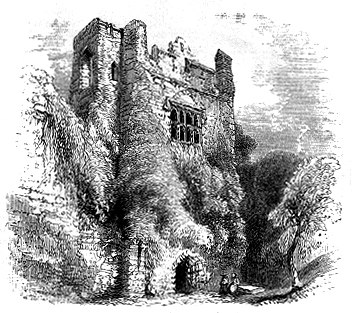|
|
On The Welsh Border.,
Page 5 of 14 doubt as old as the castle itself, which was begun directly after the Norman conquest.
Seizing the four-pound cannon-ball which, hanging by a chain, serves as a knocker, we bang at it with a racket which wakes the echoes like the knocking you may have heard at Booth’s Theatre in the play of Macbeth. Huge walnut-trees are growing within the court, and beneath the deep shade of their spreading branches stand rustic tables and settees. The walls on every side are so richly and deeply hung with ivy that they seem great banks of green leaves against the blue sky. Turning to the right, we pass through several empty rooms once used for domestic purposes, and by the door of the warden’s residence in one of the towers. Thence we go down a long, chilly flight of stone stairs to a chamber which is hallowed by a terrible story of blood. It was in the last hours of the castle’s history, two hundred and thirty years ago. Cromwell in person hhad come to besiege this stronghold, but was repulsed by a gallant knight, Sir Nicholas Kemeys by name, who held the castle with a handful of men. Cromwell retired, but left one of his officers in command of the besieging army, with instructions to starve the royalists out. The little garrison fought stubbornly for many days, but at last their provisions were exhausted. They were now promised quarter if they would surrender; but they had a boat lying in the river, just under this chamber, by which in the dead of night they intended to escape. One of Cromwell’s soldiers, taking a knife between his teeth, swain across the river, and cut the rope by which the boat was fastened, and took it away. Still the proud Sir Nicholas refused to surrender. So the besiegers assaulted the half-starved garrison, forced the castle, slew the knight and forty men, who fought to the last. In this chamber the last fierce struggle took place, and here the stubborn Sir Nicholas was cut down. The chamber is overarched with rafters of cemented stones to support the rocky roof, but it was evidently hewn out of the face of the limestone precipice. The only door is at the foot of the dark stairway by which we entered, and there is no other outlet except the window, which looks directly down upon the river. The huge iron ring to which the boat was fastened is still there in the stone floor.  Marten’s Tower.
Across the court stands the ruined keep, known in these days by the name of “Marten’s Tower,” because here was confined the famous regicide Henry Marten, and here he died in 1680, after twenty years’ imprisonment. Marten was one of Cromwell’s staunchest supporters, and signed the death-warrant of Charles I. On the restoration of monarchy he was condemned to death; but as he was one of the nineteen regicides who surrendered under Charles II.’s proclamation of mercy, the sturdy Roundhead pleaded that he had never obeyed any proclamation before this, and hoped he should not be hanged for taking the king’s word now. So he was let out of his cell in the Tower of London, and sent here under sentence of imprisonment for life. We climb about in the solemn old tower by the stone stairs which wind up in one corner, and pause on the various landings to look down into the great hollow shell. The floors have all tumbled down long ago, so that the view is unobstructed from cellar to battlements. Ridges in the wall show where the floors hung. Birds twitter and fly about the empty space, and the rich luxuriance of ivy from without flows in at the deep windows like a green snow-bank. There are fire-places visible in the walls, and in that one up yonder where the doves are billing and cooing once burned the fire which warmed the old |
|
5
Books & articles appearing here are modified adaptations
from a private collection of vintage books & magazines. Reproduction of these pages is prohibited without written permission. © Laurel O'Donnell, 1996-2006.
|
|

